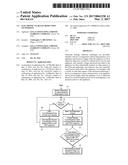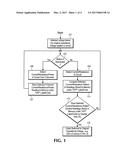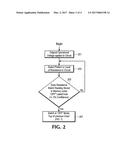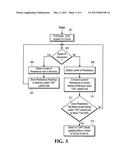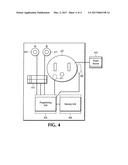Patent application title: ELECTRONIC LEAKAGE REDUCTION TECHNIQUES
Inventors:
IPC8 Class: AH01H3500FI
USPC Class:
1 1
Class name:
Publication date: 2017-03-02
Patent application number: 20170062158
Abstract:
Electronic leakage reduction techniques are provided, whereby a device is
configured to detect characteristics of an appliance and its power supply
when the appliance is off or otherwise placed in a mode for reduced power
use by said appliance, and whereby voltage and power provided to the
appliance are then substantially reduced. In other aspects of the
disclosed technology, user behavior may also manually control power
delivered to the appliance, for example, with a switch. In still other
aspects of the disclosed technology, a device is configured to detect
characteristics of an appliance and its power supply when the appliance
is on or otherwise placed in a mode for higher power use by said
appliance, and increases power to the appliance.Claims:
1.-20. (canceled)
21. A multi-functional appliance, comprising: a power saving button to place the multi-functional appliance in a power saving mode according to a power saving routine; a memory device to store the power saving routine; a power source to deliver power based at least in part on the power saving routine; and a programming device to record at least one level or at least one pattern of electrical power, resistance, or current delivered to the multi-functional appliance during the power saving routine; wherein the power saving button, the memory device, the power source, and the programming device are communicatively coupled.
22. The multi-functional appliance of claim 21, further comprising: a relay device to switch the multi-functional appliance from an original operational voltage to a power saving routine voltage; wherein the power saving button, the memory device, the power source, the programming device, and the relay device are communicatively coupled.
23. The multi-functional appliance of claim 21, further comprising: a sensor device to detect the at least one level or the at least one pattern of the electrical power, the resistance, or the current delivered to the multi-functional appliance based at least in part on the power saving button; wherein the power saving button, the memory device, the power source, the programming device, and the sensor device are communicatively coupled.
24. The multi-functional appliance of claim 21, further comprising: a selector device to select a confidence level or a power saving routine voltage; wherein the power saving button, the memory device, the power source, the programming device, and the selector device are communicatively coupled.
25. The multi-functional appliance of claim 21, further comprising: an on button to turn the multi-functional appliance on; wherein the power saving button, the memory device, the power source, the programming device, and the on button are communicatively coupled.
26. The multi-functional appliance of claim 25, wherein the programming device records at least another level or at least another pattern of the electrical power, the resistance, or the current delivered to the multi-functional appliance based at least in part on detecting activation of the on button.
27. A method of operating a multi-functional device, comprising: placing the multi-functional appliance in a power saving mode according to a power saving routine based at least in part on detecting activation of a power saving button; storing the power saving routine in a memory device; delivering power to the multi-functional appliance based at least in part on the power saving routine; and determining, using a programming device, at least one level or at least one pattern of electrical power, resistance, or current delivered to the multi-functional appliance during the power saving routine.
28. The method of operating the multi-functional appliance of claim 27, further comprising: switching the multi-functional device from an original operational voltage to a power saving routine voltage using a relay device.
29. The method of operating the multi-functional appliance of claim 27, further comprising: detecting the at least one level or the at least one pattern of the electrical power, the resistance, or the current delivered to the multi-functional appliance using a sensor device.
30. The method of operating the multi-functional appliance of claim 27, further comprising: selecting a confidence level or a power saving routine voltage using a selector device.
31. The method of operating the multi-functional appliance of claim 27, further comprising: turning the multifunctional appliance on using an on button.
32. The method of operating the multi-functional appliance of claim 31, determining, using the programming device, at least another level or at least another pattern of electrical power, resistance, or current delivered to the multi-functional appliance based at least in part on detecting activation of the on button.
33. A device, comprising: a power saving means to place the multi-functional appliance in a power saving mode according to a power saving routine; a power source means to deliver power to the multi-functional appliance based at least in part on the power saving routine; and a programming means to determine at least one level or at least one pattern of electrical power, resistance, or current delivered to the multi-functional appliance during the power saving routine and to record the at least one level or the at least one pattern of the electrical power, the resistance, or the current delivered to the multi-functional appliance during the power saving routine in a memory means; wherein the power saving means, the power source means, the programming means, and the memory means are communicatively coupled.
34. The device of claim 33, wherein the memory means to store the power saving routine and the at least one level or the at least one pattern of the electrical power, the resistance, or the current delivered to the multi-functional appliance during the power saving routine.
35. The device of claim 33, further comprising: a relay means to switch the multi-functional device from an original operational voltage to a power saving routine voltage; wherein the power saving means, the power source means, the programming means, and the relay means are communicatively coupled.
36. The device of claim 33, further comprising: a sensor means to detect the at least one level or the at least one pattern of the electrical power, the resistance, or the current delivered to the multi-functional appliance; wherein the power saving means, the power source means, the programming means, and the sensor means are communicatively coupled.
37. The device of claim 33, further comprising: a selector means to select a confidence level or a power saving routine voltage; wherein the power saving means, the power source means, the programming means, and the selector means are communicatively coupled.
38. The device of claim 33, further comprising: an on means to turn the multi-functional appliance on; wherein the power saving means, the power source means, the programming means, and the on means are communicatively coupled.
39. The device of claim 38, wherein the programming means records at least another level or at least another pattern of electrical power, resistance, or current delivered to the multi-functional appliance based at least in part on the on means.
Description:
CROSS REFERENCE TO RELATED APPLICATION
[0001] This application is a continuation of U.S. patent application Ser. No. 13/784,408, filed Mar. 4, 2013, which is a continuation of U.S. patent application Ser. No. 13/210,366, filed Aug. 15, 2011, now U.S. Pat. No. 8,410,639, which is a continuation of U.S. patent application Ser. No. 12/888,410, filed September 22, 2010, now U.S. Patent No. 7,999,415, issued August 16, 2011, which is a continuation of U.S. Patent Application No. 11/806,083, filed May 29, 2007, now U.S. Pat. No. 7,821,161, issued Oct. 26, 2010, which claims the benefit of U.S. Provisional Application No. 60/808,814, filed May 27, 2006, all the disclosures of which are hereby incorporated by reference herein in their entireties.
FIELD OF THE INVENTION
[0002] The present invention relates to techniques for reducing electronic leakage from appliances and modified electrical outlets.
BACKGROUND OF THE INVENTION
[0003] A wide variety of electrically-powered appliances are known to draw electrical current, using electrical power, even when "switched off," meaning that the appliance is placed in a relatively inactive and unused state by the user, usually by pushing a "power" button or switching a power switch to an "off" position. (These buttons are often labeled with the symbol: , or a similar symbol.) The power consumed by appliances that are "switched off," known as power "leakage," is a matter of growing public concern because the associated unnecessary use of power is tremendously wasteful of economic resources, especially in the aggregate, and contributes to the creation of atmospheric pollution associated with the production of the wasted power at plants that expel pollution, including greenhouse gasses. See generally California Energy Commission, report available at http://www.consumerenergycenter.org/homeandwork/homes/inside/appliances/s- mall.h tml.; see also http://www.energyrating.gov.au/library/pubs/cop5-leaking.pdf.
[0004] The problem of leakage has been address through "Smart Switches" built into, or retrofitted to, individual appliances, such that an appliance draws little or no current upon pressing a power button, or flipping a power switch. See generally http://www.energyrating.gov.au/library/pubs/cop5-leaking.pdf. Similarly, one may simply unplug an appliance, or switch off a "hard switch" which totally breaks an electric circuit, preventing further leakage. Another technology addresses the problem of leakage by enabling the electrical utility company to control outlets at each and all homes of the individual consumer, to reduce their "draw" at critical times of power shortage. See U.S. Pat. No. 6,828,695, "System, Apparatus and Method for Energy Distribution Monitoring and Control and Information Transmission." Yet another technology addresses leakage through a "smart" power strip, with one or more outlets designated as "control," "master" or "hot," which is constantly powered, but also monitored for current usage, and other "slave" outlets on the strip that are switched off when an appliance attached to the "control" outlet is "turned off." That technology is intended for systems, such as a computer, computer screen, computer-associated printer, etc., where the consumer may wish for all associated devices to be switched off at once, when the computer, for example, is switched off.
Some Disadvantages of Conventional Technologies
[0005] The latter technology discussed above does not address the problem of leakage from the "control,"/"master"/"hot" appliance, which will still draw power while the associated peripheral appliances are switched off. Similarly, that technology does not apply to devices that are individually turned on and off because the consumer does not wish to necessarily associate their use and disuse with some other "master" or "control" appliance. In addition, such Smart Switches integrated in newer appliances address the problem of leakage on an ongoing basis, but do not address the problem of leakage in the vast majority of existing appliances. Although a consumer may always unplug or otherwise manually break the circuit, as with a finger-actuated power strip switch, that solution requires perpetual consideration and perseverance on the part of the individual consumer. In practice, the vast majority of individual consumers leave their appliances plugged in, and leaking power, even when aware of the problem of leakage.
SUMMARY OF THE INVENTION
[0006] Electronic leakage reduction techniques are provided. In one aspect of the disclosed technology, an electrical power outlet with a programmable computing unit and means for reducing power to appliances detects whether said appliance is in "the off position," and reduces voltage to the appliance, and then monitors the level of power drawn by the appliance to determine when the appliance is in the "on position," and restores the "original operational voltage" to the appliance. More specifically, the electrical power outlet including a programmable computing unit delivers a "selected voltage below the original operational voltage" to the appliance while the appliance is in the off position, while testing the level or pattern of power, current or resistance, and restoring the original operational voltage to the appliance when said levels or patterns match the state of the appliance in the on position. Alternatively, the electrical power outlet including a programmable computing unit may deliver a particular voltage for particular durations at particular intervals to the appliance while the appliance is in the "off position," while testing the level or pattern of power, current or resistance, and restoring the original operational voltage to the appliance when said levels or patterns match the state of the appliance in the on position.
[0007] The following definitions apply to the remainder of this application:
[0008] "The off position" means that action with respect to an electrical appliance, such as switching a main power switch on the appliance to the "off" position, prescribed by the manufacturer or user for reducing power consumption by the appliance, has taken place without subsequent action prescribed by the manufacturer or user for returning the appliance to the "on" position.
[0009] "The on position" means that action with respect to an electrical appliance, such as switching a main power switch on the appliance to the on position, prescribed by the manufacturer or user for increasing power consumption by the appliance, has taken place, without subsequent action prescribed by the manufacturer or user for returning the appliance to "the off position."
[0010] "Original operational voltage" means the voltage or range of voltages applied to an appliance at which the appliance is operated, according to manufacturer's specifications or customary usage by consumers.
[0011] "Selected voltage below the original operational voltage" means a voltage below the original operational voltage and at which a level of power, resistance or current of the appliance can be identified as relating to the appliance in the on position.
[0012] "Pattern of current drawn by an electrical appliance" means a set of more than one level of current in an appliance occurring at particular timed intervals.
[0013] "Pattern of resistance of an electrical appliance" means a set of more than one level of resistance in an appliance occurring at particular timed intervals.
[0014] "Pattern of power drawn by an electrical appliance" means a set of more than on level of power in an appliance occurring at particular timed intervals.
BRIEF DESCRIPTION OF THE DRAWINGS
[0015] FIG. 1 is a diagram illustrating exemplary programming and methodology for a programmable unit of a preferred embodiment, for a mode in which a selected voltage below the original operational voltage is applied to an appliance;
[0016] FIG. 2 is a diagram illustrating additional exemplary programming and methodology for a programmable unit of a preferred embodiment, for a mode in which the original operational voltage is applied to an appliance;
[0017] FIG. 3 is a diagram illustrating additional exemplary programming and methodology for a programmable unit of a preferred embodiment, for a mode in which the original operational voltage is applied to an appliance, and illustrating additional programming by the user;
[0018] FIG. 4 is a diagram illustrating an exemplary system for performing the present techniques according to an embodiment.
DETAILED DESCRIPTION OF THE DRAWINGS
[0019] FIG. 1 is a diagram illustrating exemplary programming and methodology for a programmable unit of a preferred embodiment, for a mode in which a selected voltage below the original operational voltage is applied to an appliance. In step 101, a selected voltage, below the original operational voltage for the appliance, is applied to the appliance. As explained above, a selected voltage below the original operational voltage means a voltage below the original operational voltage and at which a level of power, resistance or current of the appliance can be identified as relating to the appliance in the on position. By applying a selected voltage below the original operational voltage to an appliance, greatly reduced power consumption due to "leakage," defined as power consumed by the appliance while the appliance is in the off position, can be achieved while monitoring the appliance for an indication that the user intends to return the appliance to the on position, which signs may include an increased electrical resistance, lower current, increased power, or a pattern of resistance, pattern of current or pattern of power associated with the electrical appliance in either or both of the on or off positions. Alternatively, a particular voltage may be applied for particular durations at particular intervals, while still falling within the scope of the disclosed technology. That alternative may be more useful where the on position or off position is more difficult to determine with respect to an appliance at lower voltages, and the resistive, power and/or current-drawing characteristics of the appliance in the on position or off position do not vary widely over time or vary according to a pattern that can be detected at said particular intervals and particular durations. In step 103, said preferred embodiment determines whether a programming button, A, is depressed by the user, which would indicate that the user intends to indicate to the programming unit of the disclosed technology that the appliance is in the off position. If button A is depressed, the programming unit proceeds to step 105, in which the programming unit detects, with the assistance of a sensor or sensors, the level or pattern of power drawn by the appliance, electrical resistance of the appliance or current drawn through the circuit made by the appliance and power outlet. It is within the scope of this disclosed technology that any of those three described electrical characteristics of the appliance may be detected and recorded. In step 107, the programming unit then records in a memory unit either the average level of power or pattern of power over a set time interval, shown as 5 seconds in FIG. 1, under a code identifying those recordings as recordings of the electrical characteristics of the appliance in the off position. It is also possible for the programming unit to record levels or patterns of electrical resistance of the appliance or current through the appliance/outlet circuit and accomplish the aims of the present disclosed technology. At that point, the programming unit returns to step 101. If, at step 103, the programming unit determines that button A is not depressed, the programming unit proceeds to step 109 and detects, with a sensor, the present levels or patterns of power drawn by the appliance, electrical resistance of the appliance or current drawn through the circuit made by the appliance and power outlet. In step 111, the programming unit compares the present levels or patterns of power drawn by the appliance, electrical resistance of the appliance or current drawn through the circuit made by the appliance and power outlet with levels or patterns recorded in the memory unit during step 107. In step 113, the programming unit then determines whether the present levels or patterns of power drawn by the appliance, electrical resistance of the appliance or current drawn through the circuit made by the appliance and power outlet match levels or patterns recorded in the memory unit during step 107. It is within the scope of this disclosed technology that there may be a confidence interval, which indicates an amount of deviation between the present levels or patterns of power drawn by the appliance, electrical resistance of the appliance or current drawn through the circuit made by the appliance and levels or patterns recorded in the memory unit during step 107. It is also within the scope of this disclosed technology that such a confidence interval may be set by the user. Such a confidence interval may be set by establishing minimum or maximum levels of electrical power drawn by the appliance, resistance of the appliance or current passing through the appliance/outlet circuit after which a match will be determined. Such a step may be accomplished through any number of programming and user interfaces which will be readily apparent to those with skill in the art. If, in step 113, the programming unit determines that the present levels or patterns of power drawn by the appliance, electrical resistance of the appliance or current drawn through the circuit made by the appliance and power outlet match levels or patterns recorded in the memory unit during step 107, the programming unit returns to step 101. If, by contrast, in step 113, the programming unit determines that the present levels or patterns of power drawn by the appliance, electrical resistance of the appliance or current drawn through the circuit made by the appliance and power outlet do not match levels or patterns recorded in the memory unit during step 107, the programming unit will cause the restoration of original operational voltage to the appliance, and discontinuation of delivery of the selected voltage below the original operational voltage. This may be accomplished by the programming unit sending a signal to a relay connected to the outlet/appliance circuit. As discussed above, the original operational voltage means the voltage or range of voltages applied to an appliance at which the appliance is operated, according to manufacturer's specifications or customary usage by consumers. Typically, in the United States, the original operational voltage for an appliance is 120 volts, at the outlet.
[0020] FIG. 2 is a diagram illustrating additional exemplary programming and methodology for a programmable unit of a preferred embodiment, for a mode in which the original operational voltage is applied to an appliance, and the programming unit has recorded levels or patterns of the appliance in the off position, as in the methodology set forth in FIG. 1. In step 201, the original operational voltage is applied to the appliance. The programming unit then proceeds to step 203, where the programming unit detects, with a sensor, the present level or pattern of resistance of the appliance. For many appliances, the characteristic level or pattern of resistance will be equivalent, within a confidence interval, across a range of voltages. This principal is well known within the art, and expressed under the common formula V=IR, where the resistance (R) may be constant while voltage (V) will alter the level of current only (I). In step 205, the programming unit then proceeds to compare the present level or pattern of resistance of the appliance with levels or patterns of resistance recorded in the memory unit during step 107 of FIG. 1. Once again, it is within the scope of this disclosed technology that a certain confidence interval with respect to the amount of difference between the present levels or patterns of resistance and those recorded in memory during step 107 before the two comparators will be found to match, under step 205. That confidence interval may be variably set by the user according to the user's experience with the effectiveness of particular confidence intervals with respect to identifying when the appliance is in the off position. It is also within the scope of this disclosed technology that such a confidence interval may be set by the user. Such a confidence interval may be set by establishing minimum or maximum levels of electrical power drawn by the appliance, resistance of the appliance or current passing through the appliance/outlet circuit after which a match will be determined. If, in step 205, the programming unit determines that the present level or pattern of resistance of the appliance matches levels or patterns of resistance recorded in the memory unit during step 107 of FIG. 1, the programming unit proceeds to step 207, in which the programming unit discontinues application of the original operational voltage to the appliance, and applies a selected voltage below the original operational voltage to the circuit, and then proceeds to step 101 of FIG. 1. Step 207 may be accomplished by the programming unit sending a signal to a relay or set of relays connected to the appliance/outlet circuit.
[0021] FIG. 3 is a diagram illustrating additional exemplary programming and methodology for a programmable unit of a preferred embodiment, for a mode in which the original operational voltage is applied to an appliance, and illustrating additional programming by the user. In step 301, the original operational voltage is applied to the appliance. The programming unit then proceeds to step 303, in which it determines whether the user has depressed button B, which indicates to the programming unit that the user intends to indicate that the appliance is in the on position. If the programming unit determines that button B is depressed, the programming unit proceeds to step 305. In step 305, the programming unit detects with a sensor either the average level of power or pattern of power over a set time interval, shown as 5 seconds in FIG. 3. Similarly, the programming unit may detect the levels or patterns of electrical resistance of the appliance or current passing through the appliance/outlet circuit. In step 307, the programming unit then records the average level or the pattern of power, electrical resistance of the appliance, or current through the appliance/outlet circuit in a memory unit, under a code identifying those recordings as recordings of the electrical characteristics of the appliance in the on position. The programming unit then returns to step 303. If, at step 303, the programming unit determines that button B is not depressed, the programming unit then proceeds to step 309. In step 309, the programming unit detects the present level or pattern of power, electrical resistance of the appliance, or current through the appliance/outlet circuit, using a sensor, over a particular interval. In step 311, the programming unit compares the present level or pattern of power, electrical resistance of the appliance, or current through the appliance/outlet circuit with the average level or the pattern of power, electrical resistance of the appliance, or current through the appliance/outlet circuit recorded in the memory unit under a code identifying those recordings as recordings of the electrical characteristics of the appliance in the on position. In step 313, the programming unit determines whether the present level or pattern of power, electrical resistance of the appliance, or current through the appliance/outlet circuit matches (which match may be determined by a confidence interval which may be variably set by the user) the average level or pattern of power, electrical resistance of the appliance, or current through the appliance/outlet circuit recorded in the memory unit under a code identifying those recordings as recordings of the electrical characteristics of the appliance in the on position. If so, the programming unit returns to Step 303. If not, the programming unit proceeds to step 315, in which the programming unit discontinues application of the original operational voltage to the appliance and applies a selected voltage below the original operational voltage to the appliance, proceeding to step 101 of FIG. 1.
[0022] FIG. 4 is a diagram illustrating an exemplary system for performing the present techniques according to an embodiment of the present disclosed technology. A user-depressible button A 401 allows the user to indicate to the programming unit 403 when the appliance is in the off position, at which time the programming unit 403 detects by connection to a sensor 405 levels or patterns of electrical power, resistance or current delivered in the circuit to an appliance via the outlet 407, according to aspects of the present disclosed technology. The programming unit 403 is also connected to a memory unit 409, which enables the programming unit to record levels or patterns of electrical power, resistance or current under identifiable codes, according to the aspects of this disclosed technology. The programming unit is also connected to a relay 411, which may switch the voltage between the original operational voltage and the selected voltage below the original operational voltage. A selector 413 connected to the programming unit 403 may be used to set any confidence intervals discussed in this specification and/or the selected voltage below the original operational voltage. A power source 415 enables the disclosed technology to provide power to the appliance. Finally, a button B 417 connected to the programming unit 403 permits the user to indicate when the appliance is in the on position, and the programming unit 403 may then also record levels or patterns of electrical power, resistance or current under identifiable codes, according to the aspects of this disclosed technology.
[0023] It is within the scope of this disclosed technology that solid-state circuitry may also be utilized to accomplish some of the objectives of this disclosed technology. For example, a variably-set (by the user) reverse-oriented circuit breaker could cause an outlet to cease delivering power below certain pre-determined power levels, which may be set by the user as corresponding to the level of power consumption by the appliance in the off position. Magnets may be interposed for the circuit to test the level of resistance and potential current of the appliance at that point to determine whether the appliance is being returned to the on position, at which time the circuit breaker may re-close according to other aspects of this disclosed technology.
User Contributions:
Comment about this patent or add new information about this topic:

